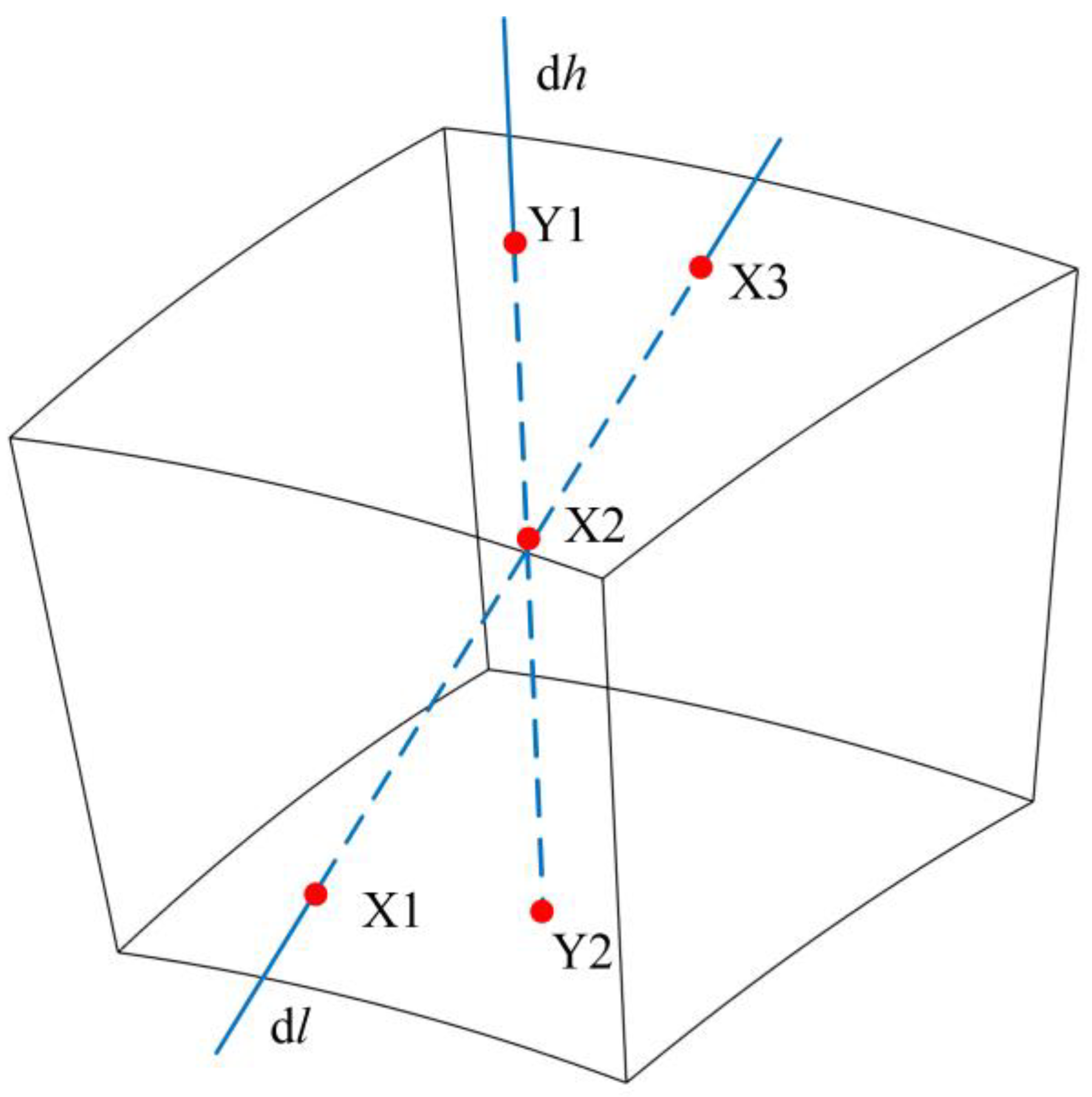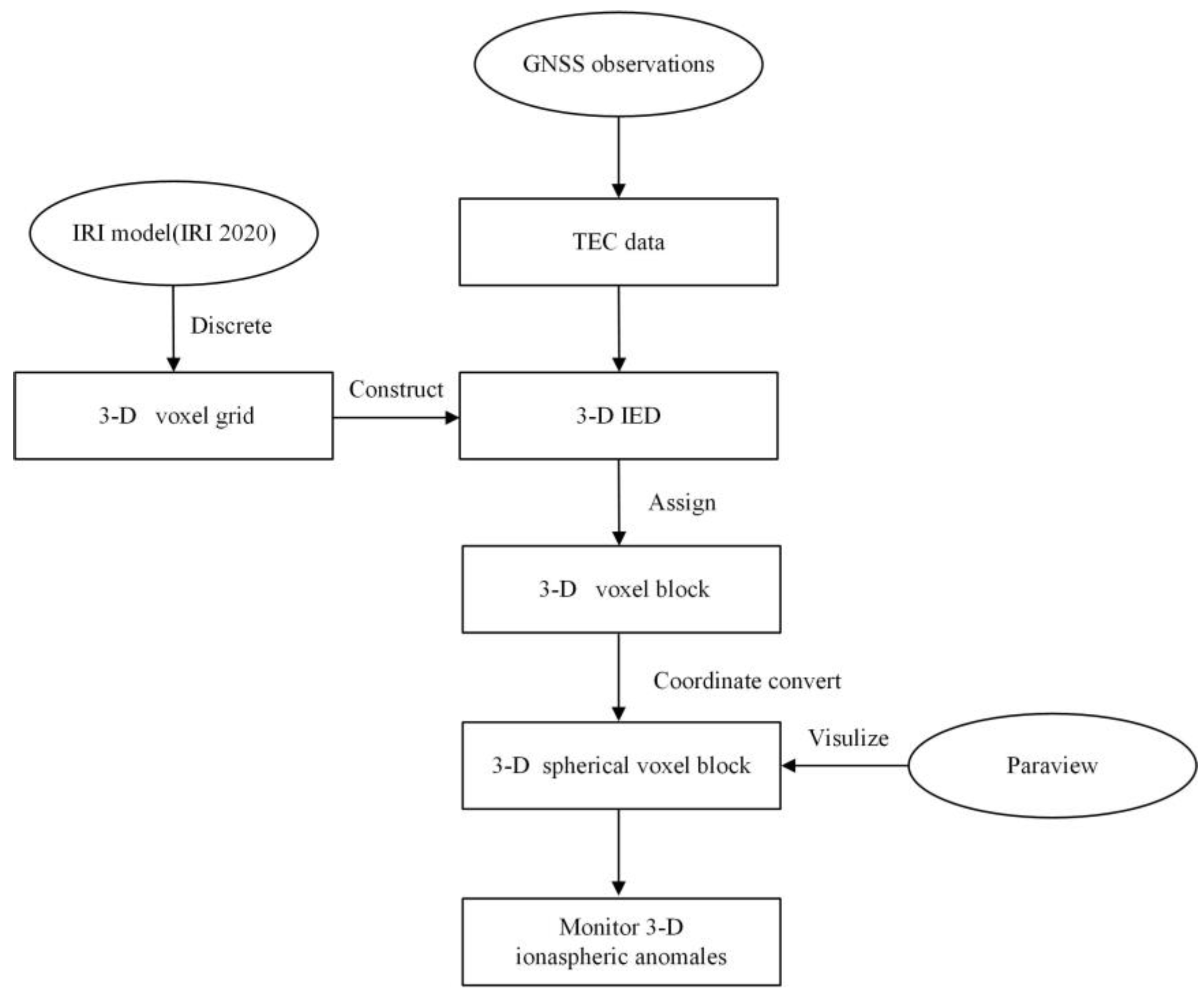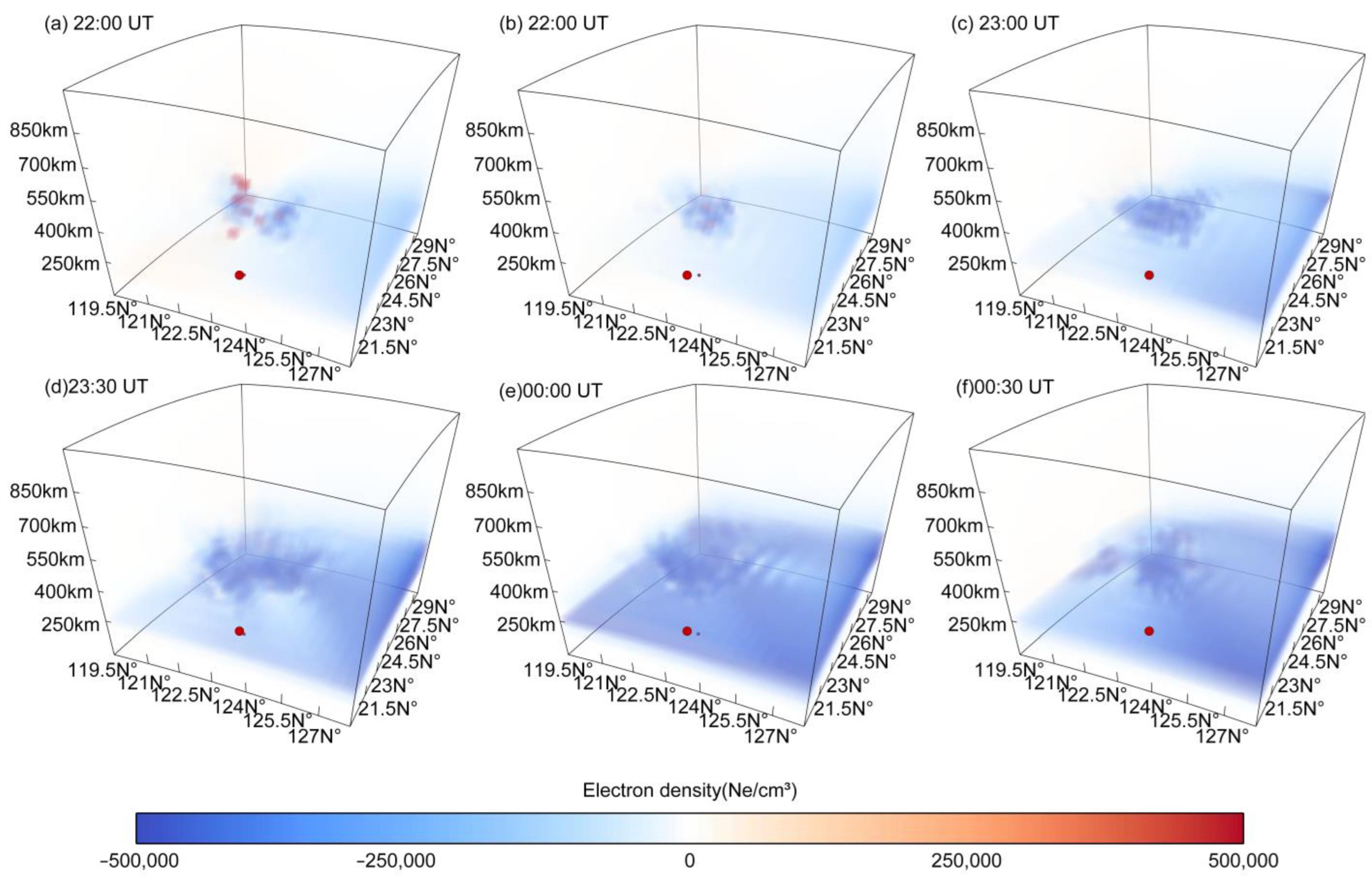Ionospheric Anomaly Identification: Based on GNSS-TEC Data Fusion Supported by Three-Dimensional Spherical Voxel Visualization
Abstract
1. Introduction
2. Datasets and Methods
2.1. Materials
2.1.1. GNSS Data
2.1.2. IRI-2020 Model
2.2. Method
2.2.1. Node-Based Parameterization Tomography
2.2.2. Visualization Model
3. Result
3.1. Case 1: Earthquake Anomaly Analysis via Spherical 3D Tomographic Ne Visualization
3.2. Case 2: Geomagnetic Anomaly Analysis via Spherical 3D Tomographic Ne Visualization
4. Discussion
4.1. Analysis of Ionospheric Disturbance of the Earthquake Case
4.2. Analysis of Ionospheric Disturbance of the Geomagnetic Storm Case
5. Conclusions
Supplementary Materials
Author Contributions
Funding
Institutional Review Board Statement
Informed Consent Statement
Data Availability Statement
Acknowledgments
Conflicts of Interest
References
- Jin, X.; Song, S.; Zhou, W.; Cheng, N. Multi-GNSS global ionosphere modeling enhanced by virtual observation stations based on IRI-2016 model. J. Geod. 2022, 96, 81. [Google Scholar] [CrossRef]
- Yao, Y.; Kong, J.; Tang, J. A New Ionosphere Tomography Algorithm With Two-Grid Virtual Observations Constraints and Three-Dimensional Velocity Profile. IEEE Trans. Geosci. Remote Sens. 2015, 53, 2373–2383. [Google Scholar] [CrossRef]
- Yao, Y.; Zhai, C.; Kong, J.; Zhao, C.; Luo, Y.; Liu, L. An improved constrained simultaneous iterative reconstruction technique for ionospheric tomography. GPS Solut. 2020, 24, 68. [Google Scholar] [CrossRef]
- Chen, B.; Wang, X.; Zhang, Z.; Jin, L.; Yu, W. Time-Dependent Ionospheric Tomography Based on Two-Step Reconstruction and Node Parameterization Algorithm. IEEE J. Sel. Top. Appl. Earth Obs. Remote Sens. 2024, 17, 15789–15805. [Google Scholar] [CrossRef]
- Wu, D.; Xie, B.; Chen, B.; Rasheed, R.; Wu, L. Characteristics of Potential Ionospheric Anomalies Prior to the M7.4 April 2, 2024 Taiwan Earthquake Identified With Multiple Observations. IEEE Geosci. Remote Sens. Lett. 2024, 21, 1003605. [Google Scholar] [CrossRef]
- He, L.; Heki, K. Three-Dimensional Tomography of Ionospheric Anomalies Immediately Before the 2015 Illapel Earthquake, Central Chile. J. Geophys. Res. Space Phys. 2018, 123, 4015–4025. [Google Scholar] [CrossRef]
- Hu, T.; Xu, X.; Luo, J. Improving the Computerized Ionospheric Tomography Performance Through a Neural Network-Based Initial IED Prediction Model. IEEE Trans. Geosci. Remote Sens. 2024, 62, 5800117. [Google Scholar] [CrossRef]
- Kao, S.-P.; Chen, Y.-C.; Ning, F.-S.; Tu, Y.-M. An LS-MARS method for modeling regional 3D ionospheric electron density based on GPS data and IRI. Adv. Space Res. 2015, 55, 2256–2267. [Google Scholar] [CrossRef]
- Hirooka, S.; Hattori, K.; Takeda, T. Numerical validations of neural-network-based ionospheric tomography for disturbed ionospheric conditions and sparse data. Radio Sci. 2011, 46, RS0F05. [Google Scholar] [CrossRef]
- Yao, Y.; Zhai, C.; Kong, J.; Zhao, Q.; Zhao, C. A modified three-dimensional ionospheric tomography algorithm with side rays. GPS Solut. 2018, 22, 107. [Google Scholar] [CrossRef]
- Lu, W.; Ma, G.; Wan, Q. A Review of Voxel-Based Computerized Ionospheric Tomography with GNSS Ground Receivers. Remote Sens. 2021, 13, 3432. [Google Scholar] [CrossRef]
- Zhang, W.; Zhang, S.; Moeller, G.; Qi, M.; Ding, N. An adaptive-degree layered function-based method to GNSS tropospheric tomography. GPS Solut. 2023, 27, 67. [Google Scholar] [CrossRef]
- Haji-Aghajany, S.; Amerian, Y.; Verhagen, S.; Rohm, W.; Schuh, H. The effect of function-based and voxel-based tropospheric tomography techniques on the GNSS positioning accuracy. J. Geod. 2021, 95, 78. [Google Scholar] [CrossRef]
- Cahyadi, M.N.; Arisa, D.; Muafiry, I.N.; Muslim, B.; Rahayu, R.W.; Putra, M.E.; Wulansari, M. Three-Dimensional Tomography of Coseismic Ionospheric Disturbances Following the 2018 Palu Earthquake and Tsunami from GNSS Measurements. Front. Astron. Space Sci. 2022, 9, 890603. [Google Scholar] [CrossRef]
- Prol, F.S.; Kodikara, T.; Hoque, M.M.; Borries, C. Global-Scale Ionospheric Tomography During the March 17, 2015 Geomagnetic Storm. Space Weather 2021, 19, e2021SW002889. [Google Scholar] [CrossRef]
- Yu, J.Q.; Wu, L.X.; Jia, Y.J. ESSG-based global spatial reference frame for datasets interrelation. Int. Arch. Photogramm. Remote Sens. Spat. Inf. Sci. 2013, XL-4/W2, 57–62. [Google Scholar] [CrossRef]
- Goodchild, M.F. Reimagining the history of GIS. Ann. GIS 2018, 24, 1–8. [Google Scholar] [CrossRef]
- Ma, T.; Zhou, C.; Xie, Y.; Qin, B.; Ou, Y. A discrete square global grid system based on the parallels plane projection. Int. J. Geogr. Inf. Sci. 2009, 23, 1297–1313. [Google Scholar] [CrossRef]
- Li, Q.; Chen, X.; Tong, X.; Zhang, X.; Cheng, C. An Information Fusion Model between GeoSOT Grid and Global Hexagonal Equal Area Grid. ISPRS Int. J. Geo-Inf. 2022, 11, 265. [Google Scholar] [CrossRef]
- Wang, R.; Ben, J.; Du, L.; Zhou, J.; Li, Z. Code Operation Scheme for the Icosahedral Aperture 4 Hexagonal Grid System. Geomat. Inf. Sci. Wuhan Univ. 2020, 45, 89–96. [Google Scholar] [CrossRef]
- Li, M.; McGrath, H.; Stefanakis, E. Multi-resolution topographic analysis in hexagonal Discrete Global Grid Systems. Int. J. Appl. Earth Obs. Geoinf. 2022, 113, 102985. [Google Scholar] [CrossRef]
- Wagner, S.; Stenzel, F.; Krueger, T.; de Wiljes, J. Drivers of global irrigation expansion: The role of discrete global grid choice. Hydrol. Earth Syst. Sci. 2024, 28, 5049–5068. [Google Scholar] [CrossRef]
- Lu, F.; Konecny, M.; Chen, M.; Reznik, T. A Barotropic Tide Model for Global Ocean Based on Rotated Spherical Longitude-Latitude Grids. Water 2021, 13, 2670. [Google Scholar] [CrossRef]
- He, L.M.; Yang, Y.; Su, C.; Yu, J.Q.; Yang, F.; Wu, L.X. Grid-based representation and dynamic visualization of ionospheric tomography. Int. Arch. Photogramm. Remote Sens. Spat. Inf. Sci. 2013, XL-4/W2, 71–76. [Google Scholar] [CrossRef]
- Wu, L.X.; Yu, J.Q.; Yang, Y.Z.; Jia, Y.J. Spatial Big Data Organization, Access and Visualization with ESSG. Int. Arch. Photogramm. Remote Sens. Spat. Inf. Sci. 2013, XL-4/W2, 51–56. [Google Scholar] [CrossRef]
- Zhang, B.; Ou, J.; Yuan, Y.; Li, Z. Extraction of line-of-sight ionospheric observables from GPS data using precise point positioning. Sci. China Earth Sci. 2012, 55, 1919–1928. [Google Scholar] [CrossRef]
- Wang, J.; Huang, G.; Zhou, P.; Yang, Y.; Zhang, Q.; Gao, Y. Advantages of Uncombined Precise Point Positioning with Fixed Ambiguity Resolution for Slant Total Electron Content (STEC) and Differential Code Bias (DCB) Estimation. Remote Sens. 2020, 12, 304. [Google Scholar] [CrossRef]
- Ren, X.; Chen, J.; Li, X.; Zhang, X. Ionospheric Total Electron Content Estimation Using GNSS Carrier Phase Observations Based on Zero-Difference Integer Ambiguity: Methodology and Assessment. IEEE Trans. Geosci. Remote Sens. 2021, 59, 817–830. [Google Scholar] [CrossRef]
- Xie, T.; Chen, B.; Wu, L.; Dai, W.; Kuang, C.; Miao, Z. Detecting Seismo-Ionospheric Anomalies Possibly Associated With the 2019 Ridgecrest (California) Earthquakes by GNSS, CSES, and Swarm Observations. J. Geophys. Res. Space Phys. 2021, 126, e2020JA028761. [Google Scholar] [CrossRef]
- He, R.; Li, M.; Zhang, Q.; Zhao, Q. A Comparison of a GNSS-GIM and the IRI-2020 Model Over China Under Different Ionospheric Conditions. Space Weather 2023, 21, e2023SW003646. [Google Scholar] [CrossRef]
- JIN, L.; CHEN, B.; WANG, X.; WU, D. Global Accuracy Assessment and Analysis of the Ionospheric Model IRI-Plas 2020 and IRI-2020 Based on GNSS Observations. Chin. J. Space Sci. 2024, 44, 1031–1046. [Google Scholar] [CrossRef]
- Alizadeh, M.M.; Schuh, H.; Schmidt, M. Ray tracing technique for global 3-D modeling of ionospheric electron density using GNSS measurements. Radio Sci. 2015, 50, 539–553. [Google Scholar] [CrossRef]
- Chen, B.; Jin, L.; Wang, J.; Jin, W.; Wang, W. Wide-Area Retrieval of Water Vapor Field Using an Improved Node Parameterization Tomography. IEEE Geosci. Remote Sens. Lett. 2023, 20, 1001805. [Google Scholar] [CrossRef]
- Chen, B.; Wu, L.; Dai, W.; Luo, X.; Xu, Y. A new parameterized approach for ionospheric tomography. GPS Solut. 2019, 23, 96. [Google Scholar] [CrossRef]
- Yu, J.; Wu, L.; Li, Z.; Li, X. An SDOG-based intrinsic method for three-dimensional modelling of large-scale spatial objects. Ann. GIS 2012, 18, 267–278. [Google Scholar] [CrossRef]
- Afraimovich, E.L.; Boitman, O.N.; Zhovty, E.I.; Kalikhman, A.D.; Pirog, T.G. Dynamics and anisotropy of traveling ionospheric disturbances as deduced from transionospheric sounding data. Radio Sci. 1999, 34, 477–487. [Google Scholar] [CrossRef]
- Nayak, K.; Romero-Andrade, R.; Sharma, G.; Zavala, J.L.C.; Urias, C.L.; Trejo Soto, M.E.; Aggarwal, S.P. A combined approach using b-value and ionospheric GPS-TEC for large earthquake precursor detection: A case study for the Colima earthquake of 7.7 Mw, Mexico. Acta Geod. Geophys. 2023, 58, 515–538. [Google Scholar] [CrossRef]
- Sharma, G.; Nayak, K.; Romero-Andrade, R.; Aslam, M.A.M.; Sarma, K.K.; Aggarwal, S.P. Low Ionosphere Density Above the Earthquake Epicentre Region of Mw 7.2, El Mayor–Cucapah Earthquake Evident from Dense CORS Data. J. Indian Soc. Remote Sens. 2024, 52, 543–555. [Google Scholar] [CrossRef]
- Meng, X.; Verkhoglyadova, O.P.; Komjathy, A.; Savastano, G.; Mannucci, A.J. Physics-Based Modeling of Earthquake-Induced Ionospheric Disturbances. J. Geophys. Res. Space Phys. 2018, 123, 8021–8038. [Google Scholar] [CrossRef]
- Wu, L.; Wang, X.; Qi, Y.; Lu, J.C.; Mao, W. Characteristics and mechanisms of near-surface atmospheric electric field 1 negative anomalies preceding the 5 September, 2022, Ms6.8 Luding earthquake. Nat. Hazards Earth Syst. Sci. 2024, 24, 773–789. [Google Scholar]
- Liu, Y.; Wu, L.; Qi, Y.; Ding, Y. General features of multi-parameter anomalies of six moderate earthquakes occurred near Zhangbei-Bohai fault in China during the past decades. Remote Sens. Environ. 2023, 295, 113692. [Google Scholar] [CrossRef]
- Wu, L.; Qi, Y.; Mao, W.; Lu, J.; Ding, Y.; Peng, B.; Xie, B. Scrutinizing and rooting the multiple anomalies of Nepal earthquake sequence in 2015 with the deviation–time–space criterion and homologous lithosphere–coversphere–atmosphere–ionosphere coupling physics. Nat. Hazards Earth Syst. Sci. 2023, 23, 231–249. [Google Scholar] [CrossRef]
- Afraimovich, E.L.; Astafyeva, E.I.; Demyanov, V.V.; Gamayunov, I.F. Mid-latitude amplitude scintillation of GPS signals and GPS performance slips. Adv. Space Res. 2009, 43, 964–972. [Google Scholar] [CrossRef]
- Vijaya Lekshmi, D.; Balan, N.; Tulasi Ram, S.; Liu, J.Y. Statistics of geomagnetic storms and ionospheric storms at low and mid latitudes in two solar cycles. J. Geophys. Res. Space Phys. 2011, 116, A11328. [Google Scholar] [CrossRef]
- Feng, J.; Zhou, Y.; Zhou, Y.; Gao, S.; Zhou, C.; Tang, Q.; Liu, Y. Ionospheric response to the 17 March and 22 June 2015 geomagnetic storms over Wuhan region using GNSS-based tomographic technique. Adv. Space Res. 2021, 67, 111–121. [Google Scholar] [CrossRef]








Disclaimer/Publisher’s Note: The statements, opinions and data contained in all publications are solely those of the individual author(s) and contributor(s) and not of MDPI and/or the editor(s). MDPI and/or the editor(s) disclaim responsibility for any injury to people or property resulting from any ideas, methods, instructions or products referred to in the content. |
© 2025 by the authors. Licensee MDPI, Basel, Switzerland. This article is an open access article distributed under the terms and conditions of the Creative Commons Attribution (CC BY) license (https://creativecommons.org/licenses/by/4.0/).
Share and Cite
Peng, B.; Chen, B.; Xie, B.; Wu, L. Ionospheric Anomaly Identification: Based on GNSS-TEC Data Fusion Supported by Three-Dimensional Spherical Voxel Visualization. Atmosphere 2025, 16, 428. https://doi.org/10.3390/atmos16040428
Peng B, Chen B, Xie B, Wu L. Ionospheric Anomaly Identification: Based on GNSS-TEC Data Fusion Supported by Three-Dimensional Spherical Voxel Visualization. Atmosphere. 2025; 16(4):428. https://doi.org/10.3390/atmos16040428
Chicago/Turabian StylePeng, Boqi, Biyan Chen, Busheng Xie, and Lixin Wu. 2025. "Ionospheric Anomaly Identification: Based on GNSS-TEC Data Fusion Supported by Three-Dimensional Spherical Voxel Visualization" Atmosphere 16, no. 4: 428. https://doi.org/10.3390/atmos16040428
APA StylePeng, B., Chen, B., Xie, B., & Wu, L. (2025). Ionospheric Anomaly Identification: Based on GNSS-TEC Data Fusion Supported by Three-Dimensional Spherical Voxel Visualization. Atmosphere, 16(4), 428. https://doi.org/10.3390/atmos16040428






